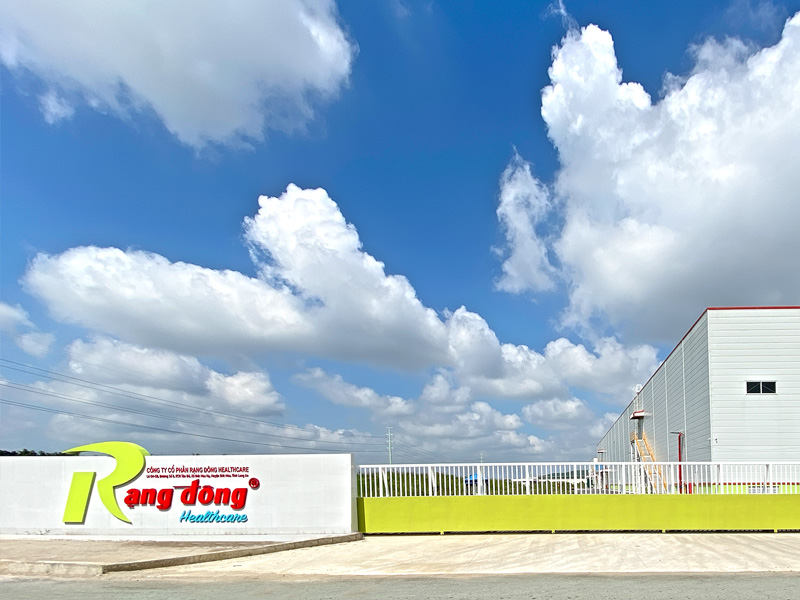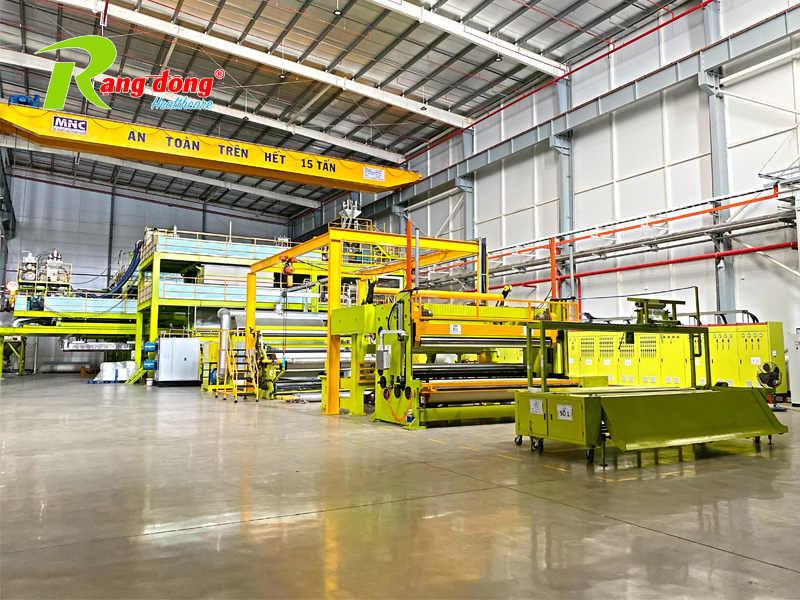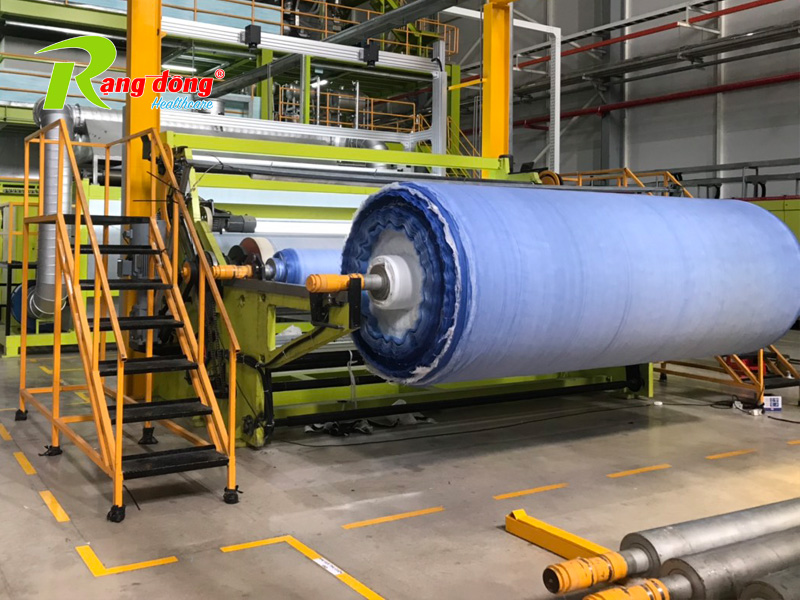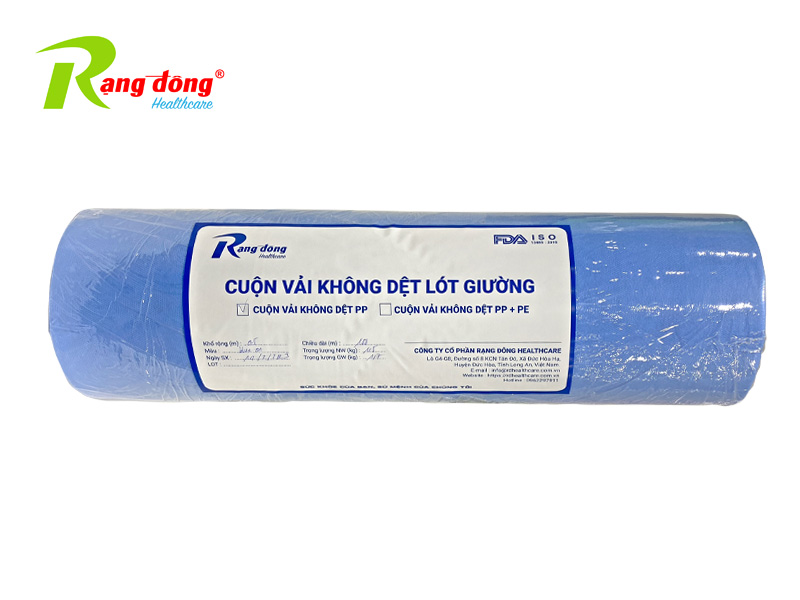Advanced non-woven fabric manufacturing technology for healthcare. Product information 18/04/2023
Rạng Đông Healthcare Joint Stock Company was established to bring high-quality, cost-effective non-woven fabric medical products to the market while ensuring health and safety. Non-woven fabric is used in various fields, with healthcare being one of the most significant. The importance of non-woven fabric in the healthcare industry includes:

- Health Protection: Used in the production of various medical products such as masks, protective clothing, medical supplies, etc., to protect users from harmful agents like bacteria, viruses, dust, and other hazardous substances.
- Cost Savings: Non-woven fabric production is more time and cost-efficient compared to traditional fabrics, resulting in durable, user-friendly, and convenient healthcare products.
- Enhanced Treatment Effectiveness: Non-woven fabric is used in the production of medical products with antimicrobial and good air filtration capabilities, improving the effectiveness of the treatment process.
Therefore, non-woven fabric is considered a crucial material in the healthcare industry, playing a vital role in safeguarding health and enhancing the effectiveness of disease treatment.
Applications of Non-Woven Fabric in the Production of Medical Products
Non-woven fabric typically possesses high durability, good elasticity, and the ability to filter and resist bacteria. Hence, it is widely used in various medical product applications, including:
- Medical Packaging and Preservation: Packaging medical products such as protective gear, sanitary napkins, towels, bed liners, and other medical items to protect them from dust, dirt, and bacteria.
- Filter Material: Manufacturing medical filters like air filters, blood filters, and water filters to remove small particles, bacteria, and other impurities.
- Surgical Use: Producing surgical gowns, surgical table covers, and patient covers to prevent the spread of infections.
- Advanced Medical Products: Manufacturing medical products such as advanced face mask filters, antibacterial and antiviral medical coats, waterproof fabric, and other high-performance medical items.
Non-woven fabric is widely used in the healthcare industry due to its versatility and multifunctionality. Medical products made from non-woven fabric reduce the risk of infection, safeguard health, and ensure safety and hygiene for patients and users.
Advanced Non-Woven Fabric Production Technology
Various Non-Woven Fabric Production Methods
Currently, there are several different methods for producing non-woven fabric, depending on its intended use, material properties, and production processes. Here are some common methods for producing non-woven fabric:
- Needle-Punching Method: This is the oldest and most traditional method of non-woven fabric production. It uses a needle to interlace fabric fibers. This method is often used to produce thick and durable non-woven fabric.
- High-Pressure Stitching Method: High pressure is used to compress fabric fibers, creating a dense layer of non-woven fabric with high durability. This method is commonly used for producing medical products, household items, and decorative fabric.
- Chemical Bonding Method: Chemicals are used to bond fabric fibers together, creating a thin, lightweight, and highly durable non-woven fabric. It is used for packaging, agricultural purposes, and medical supplies.
- Heat Bonding Method: Heat is used to bond fabric fibers, resulting in a thick and highly durable non-woven fabric. This method is employed in the production of medical products and household items.
- Ultrasonic Bonding Method: Ultrasonic waves are used to bond fabric fibers, creating a lightweight, soft, and highly durable non-woven fabric. This method is used in the production of medical products and household items.
The choice of production method depends on the intended use and technical requirements of the non-woven fabric product.
Advanced Non-Woven Fabric Production Technology for Healthcare
Utilizing advanced manufacturing and material processing techniques, advanced non-woven fabric for healthcare is designed with special features such as water resistance, antibacterial properties, odor control, breathability, ease of use, and reusability.

| MODEL | Tỷ lệ L/D | Năng suất (tấn/năm) | Độ rộng sản phẩm lớn nhất (mm) | Định lượng (g/m2) | Độ mịn của sợi tơ |
| SJ-TY-1600 | 30:1 | 1500 | 1600 | 10-200 | 2D-4D |
| SJ-TY-2400 | 2200 | 2400 | |||
| SJ-TY-3200 | 3200 | 3200 |
The choice of production method depends on the intended use and technical requirements of the non-woven fabric product.
Properties of Advanced Non-Woven Fabric for Healthcare
Advanced non-woven fabric is widely used in the medical field due to its superior properties, including:
- Filtration and Bacterial Inhibition: Manufactured using an automatic fiber bonding process without the need for chemical bonding, this creates small gaps between fabric fibers, enhancing filtration and preventing bacterial growth.
- Breathability and Moisture Absorption: The design with small gaps allows air and moisture to flow easily, providing comfort and freshness to users.
- Skin-Friendly: Made from synthetic fibers like polypropylene, polyester, and nylon, advanced non-woven fabric is hypoallergenic and reduces the risk of allergies or skin reactions.
- High Durability: Resistant to tears and external impacts, it can be used multiple times.
With these properties, advanced non-woven fabric is widely used in the production of face masks, medical bandages, medical protective clothing, and various other healthcare applications.
Applications of Advanced Non-Woven Fabric in Healthcare
Benefits of Using Advanced Non-Woven Fabric in Healthcare
Advanced Non-Woven Fabric is a type of fabric made from artificial fibers without the need for traditional weaving. It offers numerous benefits in the healthcare field, including:
- Excellent water absorption and retention: Used to make medical products like cotton pads, sanitary napkins, and other medical components. Its ability to absorb and retain water minimizes contact with fluids and secretions.
- Antibacterial Properties: Treated with antibacterial agents to prevent the growth of bacteria and fungi.
- Breathability: Offers breathability for user comfort.
- High Durability: Resistant to tears and can be used multiple times.
- Ease of Use: Can be cut into various sizes and shapes for convenient use in production.
- Environmentally Friendly: Made from eco-friendly materials, it can be recycled and biodegraded.
These benefits make advanced non-woven fabric an essential material in the healthcare industry, widely used in various applications, from manufacturing medical equipment to packaging and transporting medical products.
Standards and Regulations for Advanced Non-Woven Fabric for Healthcare
Standards and Regulations to Follow in the Production of Advanced Non-Woven Fabric for Healthcare
The production of advanced non-woven fabric for healthcare is a complex process that requires strict adherence to standards and regulations to ensure product safety and quality. Standards and regulations that must be followed in the production of advanced non-woven fabric for healthcare include:

- ISO 13485 Standard: An international standard for quality management systems in medical product manufacturing, ensuring the production of high-quality and safe medical products.
- ASTM F2100-19 Standard: An international standard for technical requirements for materials and medical products, including requirements for filtration, breathability, water resistance, barrier properties, and resistance to fluids.
- EN 13795 Standard: An international standard for technical requirements for materials and medical products, including requirements for liquid barrier performance, linting, and breathability.
- AAMI PB70 Standard: A standard from the Association for the Advancement of Medical Instrumentation (AAMI) for technical requirements for materials and medical products, including requirements for liquid barrier performance, linting, and breathability.
- FDA Standards: Standards from the U.S. Food and Drug Administration (FDA) regarding technical requirements and regulations for the manufacturing, distribution, and use of medical products.
These standards and regulations are designed to ensure the safety and quality of medical products and are widely applied in the advanced non-woven fabric manufacturing industry for healthcare.
Quality Testing Process for Advanced Non-Woven Fabric for Healthcare
The quality testing process for advanced non-woven fabric for healthcare typically includes the following steps:
- Thickness and Durability Testing: Ensures that the fabric is of the right thickness and is durable for its intended use.
- Filtration Efficiency Testing: Measures the fabric’s ability to filter out particles, bacteria, and other contaminants.
- Fluid Resistance Testing: Determines how well the fabric resists liquid penetration.
- Breathability Testing: Evaluates how easily air and moisture pass through the fabric.
- Tensile Strength Testing: Measures the fabric’s ability to withstand tension.
- Tear Resistance Testing: Assesses the fabric’s resistance to tearing.
- Linting and Particle Release Testing: Ensures that the fabric does not release lint or particles that can contaminate the healthcare environment.
- Toxicity Testing: Ensures that the fabric does not contain harmful substances.
- Biocompatibility Testing: Evaluates the fabric’s compatibility with the human body.
Overall, quality testing is an essential part of ensuring that advanced non-woven fabric for healthcare meets the required standards and regulations.
Advanced non-woven fabric plays a pivotal role in the healthcare industry, contributing to the safety and well-being of patients and healthcare workers. With various methods of production and advanced technology, non-woven fabric offers a wide range of properties such as filtration, breathability, antibacterial capabilities, and high durability, making it ideal for medical product applications. Adherence to strict standards and quality testing processes is vital to ensure that these advanced materials meet the necessary requirements for healthcare use. As technology continues to advance, non-woven fabric will continue to evolve, contributing to innovative solutions in the medical field.

The significance of non-woven fabric in healthcare cannot be overstated, as it enhances health protection, reduces costs, and improves treatment effectiveness, ultimately ensuring a safer and more efficient healthcare environment.






